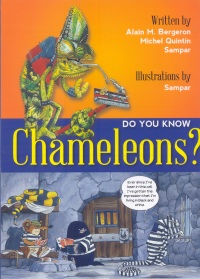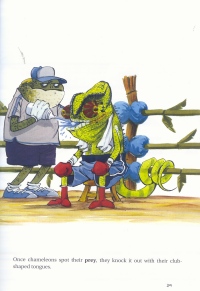| ________________
CM . . .
. Volume XX Number 5. . . .October 4, 2013
excerpt:
Do you know chameleons? The question is, “Do you know a child who likes cartoons and reading about critters that most people don’t care for?” If the answer is “yes”, Do You Know Chameleons? is a good book to pick up. It’s the most recent addition to Alain M. Bergeron, Michel Quintin, and Samuel Parent (Sampar)’s “Do You Know?” series in which each book features one fascinating, icky and downright cool species (such as spiders, crows, rhinoceroses, rats, and porcupines), with this one starring one of nature’s odder creatures, the chameleon.
Much of the book is devoted to the chameleon’s most unique features: its tongue and its ability to camouflage itself. Main events in the life cycle of the chameleon are also noted, such as mating season habits and the facts that chameleons are abandoned while still in the egg and live almost all of their lives in solitude. This book seems meant to pique interest in chameleons, and it would be a good resource for a science fair project, as well as for the curious child or budding zoologist. The vocabulary used is at times sophisticated (eg. prehensile tail), and the glossary at the back gives easily understood definitions for the more advanced terms, although the glossary, itself, uses the term “organism” which is not found in the text, and which is not defined in the glossary, itself. The sentences vary from simple to slightly more complicated. The images are concrete, however, and I suspect that children will be delighted by the way the facts are framed just as much as by the facts themselves. Other books in the “Do You Know?” series, which is written by Alain M. Bergeron, Michel Quintin, and Sampar, and illustrated by Sampar, include owls, toads, crocodiles, leeches, skunks, snakes, slugs, and scorpions. Do You Know Chameleons? was originally published in French and translated into English by Solange Messier. Alain M. Bergeron is a Québécois author who has authored some 185 books, with many of them being translated into English, Japanese, Korean and Spanish. Michel Quintin is the president and CEO of Éditions Michel Quintin, a Canadian publishing house which publishes French-language books and specializes in books about animals and nature. Samuel Parent, alias Sampar, is a self-taught artist who has been nominated for many awards, including the Mr. Christie’s Book Award. He was a finalist for Governor General’s Literary Award. His works range from zany to humourous to tender and back again. Recommended. Janet Eastwood is a student in the Master of Children’s Literature program at the University of British Columbia.
To comment
on this title or this review, send mail to cm@umanitoba.ca.
Copyright © the Manitoba Library Association. Reproduction for personal
use is permitted only if this copyright notice is maintained. Any
other reproduction is prohibited without permission.
NEXT REVIEW |
TABLE OF CONTENTS FOR THIS ISSUE
- October 4, 2013.
AUTHORS |
TITLES |
MEDIA REVIEWS |
PROFILES |
BACK ISSUES |
SEARCH |
CMARCHIVE |
HOME |

 Do You Know Chameleons? is intended for recreational readers rather than classroom use. Each page reveals a little-known fact about chameleons while cartoon-style illustrations add humour while depicting what this fact means for chameleons in a concrete, easy-to-understand manner. (Or what it might mean for anthropomorphized chameleons, anyway – the excerpt above is illustrated with a classroom scene wherein the teacher, a hedgehog, scolds a chameleon student: “How many times have I told you not to stick your tongue out at your friends?” The chameleon protests: “I didn’t do anything, Miss Cossette!” although its tongue is glommed onto the head of a student in another row, a grasshopper whose dazed expression is emphasized by stars encircling its head and a falling pencil as it slumps over its desk.) The colourful pictures are entertaining, quirky, and make the facts come alive.
Do You Know Chameleons? is intended for recreational readers rather than classroom use. Each page reveals a little-known fact about chameleons while cartoon-style illustrations add humour while depicting what this fact means for chameleons in a concrete, easy-to-understand manner. (Or what it might mean for anthropomorphized chameleons, anyway – the excerpt above is illustrated with a classroom scene wherein the teacher, a hedgehog, scolds a chameleon student: “How many times have I told you not to stick your tongue out at your friends?” The chameleon protests: “I didn’t do anything, Miss Cossette!” although its tongue is glommed onto the head of a student in another row, a grasshopper whose dazed expression is emphasized by stars encircling its head and a falling pencil as it slumps over its desk.) The colourful pictures are entertaining, quirky, and make the facts come alive.